JARS v64n1 - Rhododendron of the Year Awards, 2010
Rhododendron of the Year Awards, 2010
Ray Smith
ARS Plant Awards Committee Co-chair
Glenwood, MarylandThe ARS Plant Awards Committee has selected the Rhododendron of the Year awards for 2010. Because of climate differences, the committee selected plants for seven regions: an elepidote, a lepidote, a deciduous azalea and an evergreen azalea. The Vireya/Swisher Award is given to a vireya rhododendron.
The first criterion was that the plant perform well in the region, even for a novice. That plant had to exhibit good form, foliage and flowers, to prove itself cold and heat hardy for the region, and to show resistance to pests and diseases. In addition, the plant must be available in the nursery trade and the name registered by the International Cultivar Registration Authority.Northeastern Region
'Calsap' : Elepidote ('Catalgla' x 'Sappho'). Lavender buds open to form conical trusses of wavy white flowers with a striking burgundy blotch; a late midseason bloomer densely covered in smooth, oblong-shaped, emerald green foliage; grows to 4' (1.2 m) in ten years, being more wide than tall at maturity; hardy to -25°F (-31°C), M. W. Michener hybrid.R. mucronulatum : Lepidote. A wide-ranging deciduous native of Siberia, Mongolia, China, Korea and Japan, often called the Korean rhododendron; one of the earliest rhododendrons to bloom, the flowers often appearing before the leaves about the same time as forsythia; an open-growing, multi-branched shrub with an upright and rounded habit; its wide native habitat leads to many variant forms and varied flower colors ranging from reddish-purple to purplish pink, with an occasional white flowered form; grows 3-8' (0.9-2.4m) tall with a similar width, hardy to -20°F (-29°C) ); light to medium green leaves with deep red, purple and mahogany fall colors; a tough plant, often misclassified as an azalea.
'Millennium' : Deciduous Azalea ('Weston's Sparkler' (s) x 'Weston's Parade'). Blooming in July, the fragrant red flowers with an orange flare add color to the summer garden; an upright-growing plant, reaching 4-5' (1.2-1.5m) in ten years; mildew resistant bluish green foliage with silvery undersides; hardy to -20°F (-29°C); Ed Mezitt/Weston Nurseries hybrid.
R. kiusianum : Evergreen Azalea. Native to the mountains and volcanoes of the Japanese island of Kyushu, growing from 2000-5000' (610-762 m) in altitude; plant habit varies a great deal with altitude; forms a compact, heavily branched, often dainty plant, with tiny leaves, growing to 2' (0.6 m) in ten years; buds young and heavily, developing a solid mass of fragrant flowers, ranging in color from pure white to pure pink through light purple to nearly true red; hardy to -10°F (-23°C); a midseason bloomer good for bonsai as well as the garden.

|

|
|
|
Elepidote:
'Calsap'
Photo by S. Henning |
Lepidote:
R. mucronulatum
Photo by H. Greer |

|

|
|
|
Deciduous Azalea:
R. 'Millennium'
Photo by H. Greer |
Evergreen Azalea:
R. kiusianum
Photo by P. Osborn |
Mid Atlantic Region
'Scintillation' : Elepidote (unknown). A strong growing plant with large stems, providing strength to support the large and beautiful pastel pink flowers; blooms midseason; superb glossy dark green foliage has a heavy waxy texture and curls interestingly; grows to 5' (1.5 m) in ten years; hardy to -15° F (-26° C); a Dexter hybrid, received the ARS Award of Excellence in 1973.'Mary Fleming' : Lepidote ( R. racemosum x R. keiskei x R. keiskei ). Early midseason blooms with very light tan flowers flushed with streaks of light purplish-pink; forms a dense, finely branched, compact plant eventually growing to 3' (0.9 m); attractive foliage with good winter color, shading bronze; hardy to -15° F (-26° C), a Nearing hybrid; 1973 ARS Award of Excellence.
'Klondyke' : Deciduous Azalea (unknown). Large trusses of deep golden-yellow highlight this fragrant midseason bloomer; its mildew-resistant foliage is a striking bronze when new, then turns mahogany in the fall; plant has an upright growth habit, reaching 4-5' (1.2-1.5 m) in ten years; winner of the English Award of Garden Merit; a Knap Hill hybrid hardy to -20° F (-29° C).
'Carrie Amanda' : Evergreen Azalea ('Elsie Lee' (s) x 'Marian Lee'). Single white 2.5" (6.4 cm) flowers with a purplish pink border; the earliest bicolor to bloom; the colored margin is unstable in young plants; low and spreading, has a very compact habit, (2' x 2') (0.6 x 0.6 m) in 10 years; hardy to -15° F (-26° C); H. R. Schroeder hybrid.

|

|
|
|
Elepidote:
'Scintillation'
Photo by R. Knight |
Lepidote:
'Mary Fleming'
Photo by D. McKiver |

|

|
|
|
Deciduous Azalea:
'Klondyke'
Photo by H. Greer |
Evergreen Azalea:
'Carrie Amanda'
Photo by C. Bird |
Southeastern Region
'Queen Anne's' : Elepidote ( R. brachycarpum x R. catawbiense x unnamed white R. fortunei hybrid). This Henry Skinner hybrid is one of the few double flowered rhododendrons; an early midseason bloomer that buds very young and very heavily; the funnel-shaped, wavy lobed flowers open very pale violet quickly fading to pure white; has a rounded, open habit, growing to 4-5' (1.2-1.5 m) in ten years with excellent glossy olive green foliage; wide ranging hardiness reports, but probably hardy a good bit below 0°F (-18°C) as it does well as far north as eastern Massachusetts.
'Dora Amateis' : Lepidote. ( R. minus Carolinianum Group (s) x R. ciliatum ). Compact and low-growing (to 3' (0.9m)) in 10 years), making an excellent foundation or border plant; a bushy shrub covered with pure white flowers with a spicy fragrance in early midseason; dense deep green foliage accented with bronze tones; often wider than tall and does well in full sun; hardy to -15°F (-26°C); hybridized by Edmond Amateis; received the Award of Excellence from the American Rhododendron Society and the First Class Certificate in 1981 from the Royal Horticultural Society.
R. flammeum : Deciduous Azalea. Formerly known as R. speciosum , sometimes called the Oconee Azalea; native to the Piedmont region of Georgia and South Carolina; date of discovery not known, but first described at Kew Gardens in 1789, probably sent there by William Bartram; extremely variable in plant size and color, with colors ranging from yellowish orange, through orange to deep red, with an occasional pink; mid to late spring, 1.5 " (3.8 cm) blossoms are not fragrant, usually have a blotch, and are often held in ball-shaped trusses; heat tolerant and tolerates drier soil than most deciduous azaleas, hybridizes readily in the wild and holds much breeding potential where hot summer stress is a problem; can grow very large and hardy to -5°F (-21°C).
Midnight Flare' : Evergreen Azalea ('Red Red' (s) x 'Red Slippers'). Waxy midseason flowers, deep red in bud, opening deep red throughout, with large spots on the dorsal lobe; hardy to -5°F (-21°C), with a squat, spreading habit, growing to 3-4' (0.9-1.2m) in ten years; large and textured dark bluish green leaves turn dark red in the fall; one of many recently registered James Harris hybrids that have been around for a number of years.

|

|
|
|
Elepidote:
'Queen Anne's'
Photo by H. Greer |
Lepidote:
'Dora Amateis'
Photo by D. McKiver |

|

|
|
|
Deciduous Azalea:
'Gibraltar'
Photo by H. Greer |
Evergreen Azalea:
'Conversation Piece'
Photo by D. Hyatt |
Great Lakes Region
'Trinity' : Elepidote ('Powell Glass' selfed x R. yakushimanum 'Koichiro Wada'). Free flowering Orlando Pride hybrid developed in western Pennsylvania; pink buds open to funnel-shaped white flowers with faint purplish pink shading when first open; a late midseason bloomer with a faint fragrance; broad, rounded, well branched plant with thin indumentum and tomentum on new leaves; very hardy, to -25°F (-31°C).'Windbeam' : Lepidote ('Conestoga' seedling). A very hardy -25°F (-31°C), early midseason bloomer opening white tinged apricot, aging to white, then becoming light purplish-pink; growing to 4' (1.2 m) in ten years with small aromatic foliage; a Nearing hybrid, received the ARS Award of Excellence in 1973.
'Fragrant Star' : Deciduous Azalea (chemically induced polyploid form of 'Snowbird'). Result of colchicine treatment of natural hybrid 'Snowbird' ( R. atlanticum x R. canescens ); extremely fragrant yellowish-white midseason blooms with blue-green foliage, both flowers and leaves larger than 'Snowbird;' heat and sun tolerant; an upright grower reaching 3-4' (0.9-1.2 m) wide and 4' (1.2 m) tall in ten years; hardy to -20°F (-29°C); developed by Briggs Nursery.
'Martha Hitchcock' : Evergreen Azalea ( R. mucronatum x 'Shinnyo-no-tsuki'). Midseason 3" (7.5 cm) white flowers edged strong purplish red; younger plants or shoots may produce variant flowers, often purplish-pink solids; hairy, dark dull green leaves on a plant with a broad and spreading habit, growing to 4' (1.2 m) in ten years; hardy to -15°F (-26°C), a Ben Morrison/Glenn Dale hybrid introduced in 1948; Award of Merit in 1972 and First Class Certificate in 1976 from the RHS.

|

|
|
|
Elepidote:
'Trinity'
Photo by H. Greer |
Lepidote:
'Windbeam'
Photo by E. Philp |

|

|
|
|
Deciduous Azalea:
'Fragrant Star'
Photo H. Greer |
Evergreen Azalea:
'Martha Hitchcock'
Photo by P. Littlefield |
South Central Region
'Michelle Smith' : Elepidote ('Scintillation' (s) x R. hyperythrum ). An early bloomer with pink buds opening to large white flowers thickly dappled with maroon flecks; the wavy-edged, funnel-shaped blooms are held in a ball-shaped truss; an excellent foliage plant, with glossy, dark green leaves, growing 4-5' (1.2-1.5 m) in ten years; a heat tolerant John Thornton hybrid.'Olga Mezitt' : Lepidote ( R. minus , compact selection x pink-flowered R. dauricum hybrid). In spring, the plant is transformed by small tight balls of clear pink covering every limb; blooms early, a little later than the PJM Group, often avoiding that late frost; in fall, the bright light green summer leaves turn a beautiful mahogany adding great color to the winter garden; an upright grower, reaching 5-6' (1.5-1.8 m) in ten years; hardy to -15°F (-26°C) and sun tolerant--especially valuable in gardens without much shade; an Ed Mezitt/Weston Nurseries hybrid named for Ed Mezitt's mother.
'Homebush' : Deciduous Azalea (unknown). Very popular, upright growing Knap Hill hybrid; semi-double, rose pink blooms in a delightful ball shaped truss of up to 16 flowers; hardy to -20°F (-29°C), growing to 6' (1.8 m) in 10 years; a different and attractive conversation piece; Award of Merit in 1950 from the RHS.
'Margaret Douglas' : Evergreen Azalea ( R. indicum x 'Hatsu-shimo' x 'Shinsei'). One of the Back Acres hybrids developed by Ben Morrison; single, funnel-shaped, 3" (7.5 cm) pale pink flowers with a deeper salmon-pink edge; heat tolerant and hardy to -5°F (-21°C); has a spreading habit, growing wider than tall, reaching 4' (1.2 m) in height in ten years; a late midseason bloomer showing a moderate resistance to Phytophthora cinnamomi .

|

|
|
|
Elepidote:
'Michelle Smith'
Photo by L. Miller |
Lepidote:
'Olga Mezitt'
Photo by R. Billings |
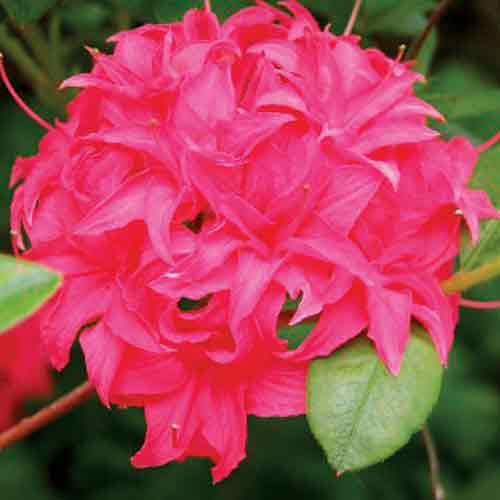
|
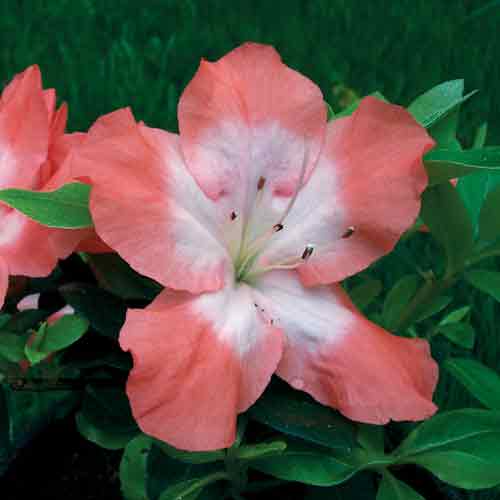
|
|
|
Deciduous Azalea:
'Homebush'
Photo D. Keough |
Evergreen Azalea:
'Margaret Douglas'
Photo by D. Hyatt |
Northwestern
'Seaview Sunset' : Elepidote ('Nancy Evans' (s) x 'Canadian Sunset'). Vivid reddish-orange buds open light yellow with a broad band of reddish-orange; a deep yellowish pink outside; 16 wavy edged flowers, 2" (5.1 cm) across, in a dome-shaped truss; early bloomer, compact habit, 2.5-3' (0.8-0.9 m) in ten years; semi-glossy, dark green leaves; Frank Fujioka hybrid whose hardiness is still open to question, perhaps to 0°F (-18°C).'Too Bee' : Lepidote ('Patricia' (s) x R. keiskei 'Yaku Fairy'). Vivid red buds open to moderate pink flowers, lighter in the throat, with strong red spotting in the throat and a darker pink outside; very wavy-edged flowers held with 3-5 in a truss; a well-branched habit, mounding to 1' (0.3 m) tall in ten years, becoming perhaps twice as wide as tall; an early midseason bloomer with small, elliptical leaves only about 1" (2.5 cm) long; hardy to -10°F (-23°C); a Warren Berg hybrid very popular with rock gardeners.
'Gibraltar' : Deciduous Azalea (unknown). Has a large full truss of brilliant frilled orange flowers with a red flush, coming from deep crimson orange buds; compact growing habit, to 6' (1.8 m) in 10 years; a midseason bloomer, hardy to -20°F (-29°C); mildew resistant Knap Hill hybrid and one of the best and most reliable deciduous hybrids; has been a Rhododendron of the Year selection for all areas of the United States.
'Rosebud' : Evergreen Azalea ('Louise Gable' x 'Caroline Gable'). This Joe Gable hybrid derives its name from the opening buds' resemblance to rosebuds; deep purplish pink, double hose-in-hose flowers in late midseason; a slow grower, with a dense, spreading habit, reaching 4' (1.5 m) in 25 years; glossy, mid green leaves and hardy to -10°F (-23°C); often confused with the taller and faster growing 'Lorna,' a Gable hybrid from the same cross; received the Award of Merit in 1972 and the First Class Certificate in 1975 from the RHS.
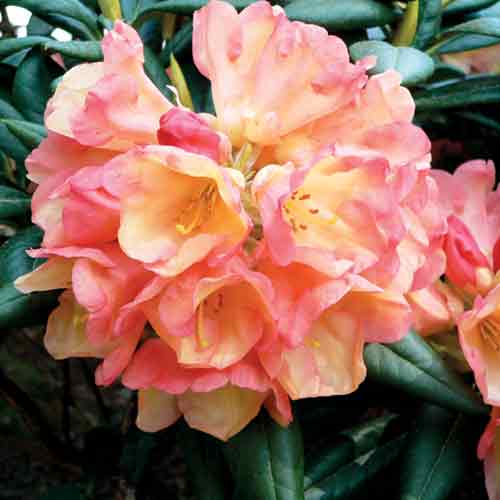
|
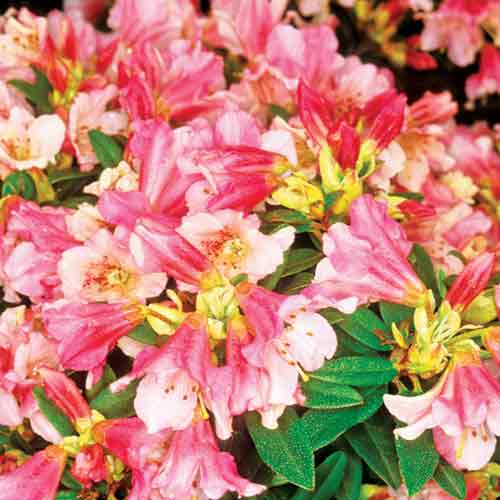
|
|
|
Elepidote:
'Seaview Sunset'
Photo by T. Hewitt |
Lepidote:
R. 'Too Bee'
Photo by H. Greer |
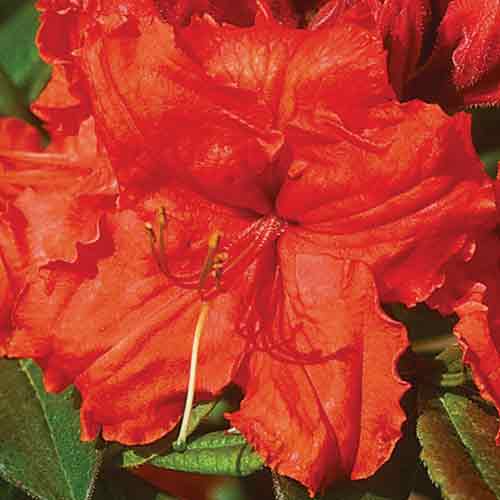
|
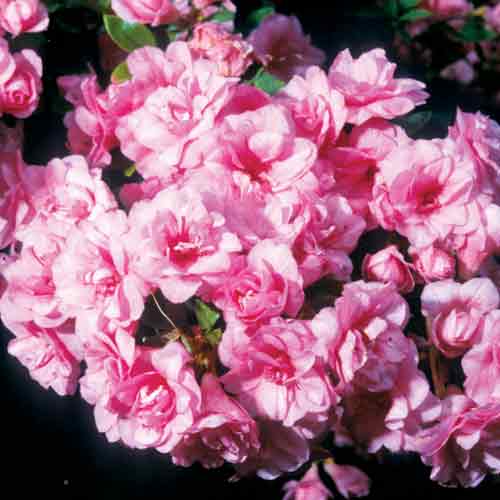
|
|
|
Deciduous Azalea:
R. 'Gibraltar'
Photo by H. Greer |
Evergreen Azalea:
'Rosebud'
Photo by H. Greer |
Southwestern Region
'Captain Jack' : Elepidote ('Mars' (s) x R. facetum ). A midseason bloomer with waxy blood red flowers in full upright trusses of 20 or more flowers; a large plant, growing to 6' (1.8 m) or more in ten years and having large leaves with unusual rolled edges; has a rather open, upright habit, but fills out more as it ages; hardy to 0°F (-18°C); does best with some shade; hybridized by Rudolph Henny in Oregon and winner of the RHS Award of Merit, 1998.'Fort Bragg Centennial' : Lepidote (selection from R. maddenii subsp. crassum ). Large (5.5" (14 cm) across) and very fragrant, funnel-shaped yellowish-white flowers with a yellow throat held in a lax truss of five flowers; a late midseason bloomer with glossy, dark green foliage and very dark, smooth, peeling bark; grows to about 4' (1.5 m) in ten years and hardy to 20°F (-7°C); grown by Bowman in Fort Bragg, California, in early twentieth century.
'Arneson Gem' : Deciduous Azalea ('C.B. van Nes' x 'Koster's Brilliant Red' (s) x unknown). Large, lightly scented golden flowers edged with bright, glowing orange emerge from strong red buds; a vigorous, yet compact grower, with an upright, spreading habit, to 3' x 4' (1.2 x 1.5 m) in 12 years; makes a striking display with its midseason blooms; hardy to -20°F (-26°C); a mildew resistant Arneson hybrid.
'Betty Anne Voss' : Evergreen Azalea ('Louise Gable' x 'Tama-giku' (s) x 'Shinnyo-no-tsuki'). Forms a compact mound of 3" (7.5 cm) hose-in-hose, double pink flowers with beautiful dark green foliage; the late midseason buds open like rosebuds; free branching and heavy flowering dwarf, growing wider than tall; hardy to -10°F (-23°C); a Robert Gartrell/Robin Hill hybrid named after his daughter.
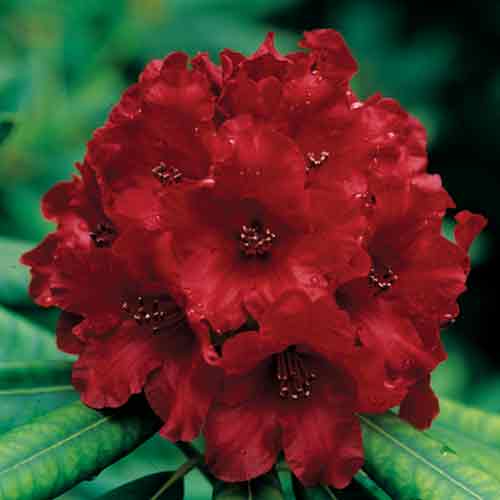
|
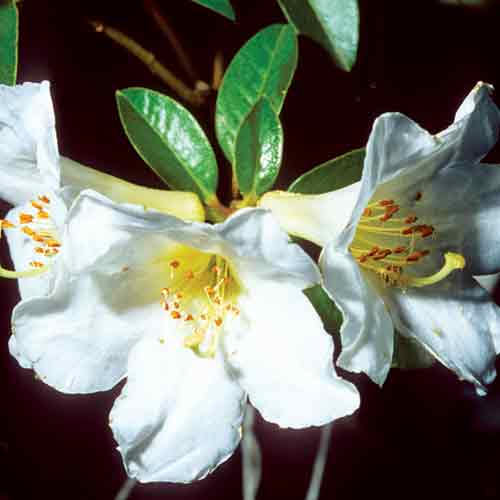
|
|
|
Elepidote:
'Captain Jack'
Photo by E. Philp |
Lepidote:
'Fort Bragg Centennial'
Photo by H. Greer |
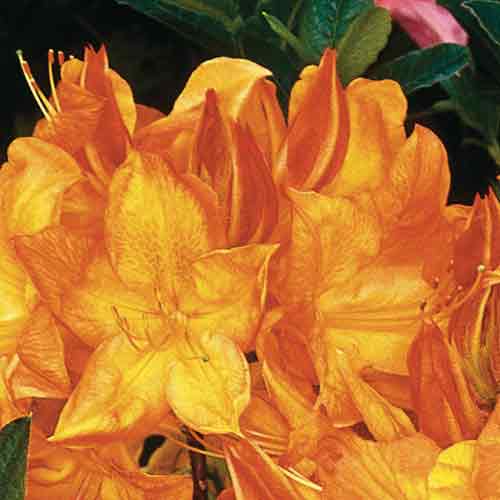
|
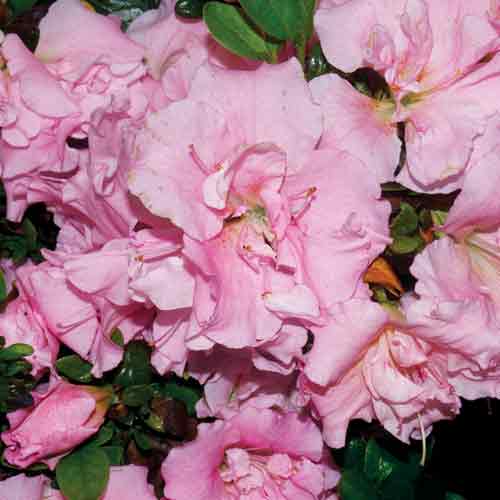
|
|
|
Deciduous Azalea:
R. 'Arneson Gem'
Photo by H. Greer |
Evergreen Azalea:
'Betty Anne Voss'
Photo by H. Greer |
Swisher/Vireya
'Taylorii' : ('Princess Alexandra' (s) x R. bookeanum subsp. gracile ). Has a compact growth habit with shiny foliage, richly colored with red veins and stems; 8-10 or more bright pink flowers with a white tube held in a rounded truss; a reliable bloomer and a good repeat bloomer with the best flush of flowering in October-January; J. Veitch & Sons hybrid awarded the First Class Certificate from the RHS in 1877.
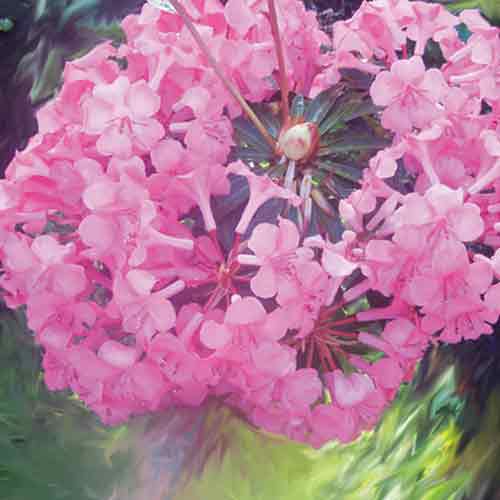
|
|
Vireya:
'Taylorii'
Photo by S. Bertelmann |
